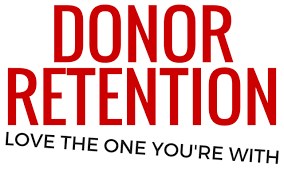Donor retention is truly the ultimate goal of every non-profit organization. Once we receive a one-time donation, the whole machine starts working to try to keep that donor on board. And from both ends it can make things more efficient, as we have read in previous blogs here about personal philanthropy. If a donor stays with one organization for a number of years, it can make the most amount of impact. Donors and non-profit organizations should want to stay together once they match up.
So where are the struggles with this task?
A. Competition
The number of non-profit organizations is exploding. According to the National Center for Charitable Statistics (NCCS) there are over 1.5 million nonprofit organizations registered in the U.S.
This number is simply staggering! Our society is definitely evolving and part of the benefits of technology and a global economy have meant that more and more non-profits are being created to conquer local and global issues. But this can be a rough competition for donor dollars.
B. Inability to Personalize
As the number of non-profit organizations grow, so does the number of donors. More people than ever are donating these days, but the level of personalization is falling. It used to be that you knew your donors by name because they came into your local office and handed you a cheque. In the anonymous online global world that we now live in, your donor could be halfway around the world. It’s not quite so easy to make them feel loved and like part of the family when your only medium is Facebook or another online tool.
C. Donation Access
One key aspect to collecting donations is the ability to have a good donation collection system on any device, available anywhere. This requires a lot of technological work and expertise. Donors want to be able to text message a donation or give via bit coin. All of this moving technology makes it difficult to stay up to date.
D. Failing to Give Thanks
Donors want gratitude and that is no secret. Yet, even to this day, many organizations are failing to utter these words due to time constraints and other operational aspects that keep their people busy.

Now, in order to refute these points and grow a solid donor retention model, it’s important to consider each of them individually:
1. Competition
STAND OUT. Ask yourself what is it that makes your organization so unique from all the other organizations that are also rescuing animals and centre everything around that. Just like a business defines their USP (Unique Selling Proposition) so must a non-profit organization. Get very clear on your target audience, on the problem your organization solves and on the benefits to your audience for solving that problem. Turn that into one clear, concise statement and voila – you have your USP for the whole world to see. This will enhance your mission by attracting only donors that are 100% on board with what it is that you’re trying to accomplish. They will feel more compelled to accomplish this with you.
2. Personalization
In this new world of technology, it’s all about personalization. Some people may think the new world is lacking a personal touch because face-to-face conversations are replaced by screens and mobile devices. However, technology has made it possible to get to know your donors intimately and to use their likes and interests to keep them engaged. Collect all the data you can on defined donor groups and use this to communicate relevantly with them.
3. Access
We know that a huge amount of time is spent on mobile phones without even looking up any significant stats. It’s a lot. And as more and more of the world becomes absorbed into their phones, more businesses and organizations must react and make themselves accessible there. If you need to learn about online donations and how to make them secure for mobile devices, send a team to learn about it. If you see that your donors might like to give small donations by text message or a monthly credit card auto transfer, figure out how to give them that option. And the sooner the better. Accessibility is key to keeping good donors on board.
4. Appreciation
And the biggest road to donor retention starts with pure appreciation for the money and time that is being donated. A holistic approach to donor appreciation is healthy for any organization and it’s employees. Does everyone truly feel it? Perhaps mindfulness techniques can be incorporated into your employees training in order to really inject enthusiasm and care into this aspect of their work. One thing we know for sure is that a little appreciation will go a long way.
Sources:
http://grantspace.org/tools/knowledge-base/Funding-Research/Statistics/number-of-nonprofits-in-the-u.s

